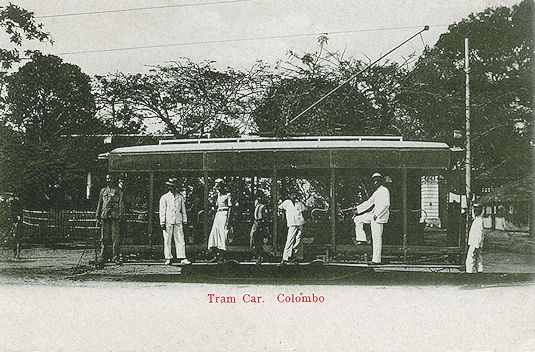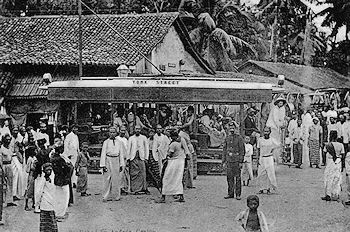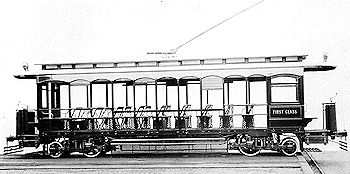

Our postcard shows a typical cross-bench tram of the early era. It is from an unknown local publisher, has an undivided back and dates from around 1904. The smaller view below was produced in Colombo around 1905 and is an extract from card No.37 in a series by local publisher Andrée. Colombo is the capital city of Ceylon, a former British Colony which has been known since 1972 as the Republic of Sri Lanka.
In 1892 the Colombo Municipal Council undertook tendering for building tramways which was won by Boustead Brothers, a British company. In 1897 construction work commenced, including the building of the Pettah Power Station, and was finished towards the end of 1899. Trams first ran for the public on 11th January 1900. Control of the company was transferred to the Colombo Electric Tramway and Lighting Co Ltd in 1901 as the tramway operator and also as supplier of electricity for street lighting and for government and commercial buildings.
 The tramway was built to 3ft 6in gauge, i.e. British narrow gauge but also sometimes known as 'Cape' gauge, as was common with many British Colonial tramways. There were seven and a half miles of route and at its peak ran 52 trams. The system was two routes, both of which commenced at a terminus in the Fort district, opposite the Grand Oriental Hotel. The first ran north-east via Pettah Market and Messenger Street to the River Kelani at Grandpass. The second route went south-east via York Street and Maradana Road to Borella. The Depot was by the Pettah Power Station.
The tramway was built to 3ft 6in gauge, i.e. British narrow gauge but also sometimes known as 'Cape' gauge, as was common with many British Colonial tramways. There were seven and a half miles of route and at its peak ran 52 trams. The system was two routes, both of which commenced at a terminus in the Fort district, opposite the Grand Oriental Hotel. The first ran north-east via Pettah Market and Messenger Street to the River Kelani at Grandpass. The second route went south-east via York Street and Maradana Road to Borella. The Depot was by the Pettah Power Station.
The initial trams of 1899 (as on our postcards) were open-sided cross-bench cars on 4-wheel trucks of the generic Brill 21E type. The Dick, Kerr group supplied equipment for Colombo, including the generators for the power station, and these trams were probably supplied by them under a sub-contract to the Electric Railway and Tramway Carriage Works (ER&TCW) of Preston, UK, which was a Dick, Kerr company.
 A little later the United Electric Car Company (UEC), the name of ER&TCW after 1905, supplied some similar but longer cars on Brill 22E reversed maximum traction bogies (UEC photo right). The trams carried first and second-class passengers, with the first-class at one end, the bogie cars having a separate first-class saloon. Later cars were enclosed with centre entrances.
A little later the United Electric Car Company (UEC), the name of ER&TCW after 1905, supplied some similar but longer cars on Brill 22E reversed maximum traction bogies (UEC photo right). The trams carried first and second-class passengers, with the first-class at one end, the bogie cars having a separate first-class saloon. Later cars were enclosed with centre entrances.
On 23rd January 1929 there was a tramcar strike for better conditions encouraged by A. E Goonesinha's Ceylon Labour Union. Management and volunteers then drove the trams, prompting a boycott of the tramway by the public. On the 5th February 1929, a clash took place between the police and the strikers, with the Maradana Police Station being set on fire. The strike then ended after negotiations. On 31 Aug 1944 the tramway was acquired by the Colombo Municipal Council. By then it was in poor condition. The council eventually decided to phase it out, with the last car running on 30th June 1960. Trolleybuses built in Britain by BUT with double-deck Weymann bodies ran between 22nd July 1953 and 1st December 1964 when they too were replaced by motor buses.
![]() Go to Postcard Of The Month Index
Go to Postcard Of The Month Index